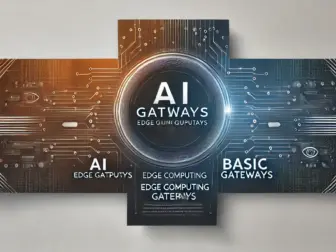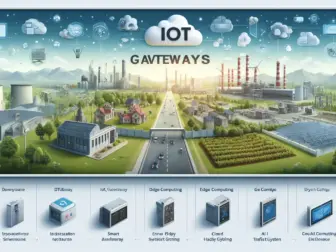Tag - Edge Computing Gateway
Blog , June 6, 2024 , AI Gateway, AI in IoT, Cloud Computing, Cloud-Edge Collaborative Gateway, CoAP, Data Acquisition Gateway, Data Transmission, Edge Computing, Edge Computing Gateway, Industrial IoT, IoT Applications, IoT Gateway, IoT Gateway Selection, Real-time Data Processing, Smart Gateway, Smart Traffic
Exploring the Potential of Edge Computing Gateway Edge computing gateway is a critical component in the realm of edge computing, enabling organizations to process data closer to the source. This technology plays a crucial role in optimizing data processing and reducing latency, making it an essential tool for industries like healthcare, manufacturing, transportation, and more. By bringing computing power closer to where data is generated, edge computing gateway enhances efficiency and responsiveness, leading to improved decision-making and operational performance. One of the key advantages of edge computing gateway is its ability to overcome the limitations of traditional cloud computing. With edge computing, data processing occurs locally on the edge device or gateway, reducing the need to transmit data back and forth to a centralized cloud server. This not only minimizes network congestion but also enhances data security and privacy, as sensitive information can be processed locally without being exposed to potential cyber threats. Moreover, edge computing gateway facilitates real-time data analytics, enabling organizations to derive actionable insights from massive amounts of data generated by IoT devices, sensors, and other connected devices. By processing and analyzing data at the edge, organizations can respond swiftly to changing conditions, make informed decisions, and automate processes in real-time. This capability is particularly beneficial for industries that rely on time-sensitive data, such as autonomous vehicles, smart grids, and smart cities. Another significant benefit of edge computing gateway is its scalability and flexibility. Organizations can deploy multiple edge gateways across distributed locations to accommodate varying workloads and optimize data processing based on the proximity to data sources. This distributed architecture not only improves performance but also enhances reliability by eliminating single points of failure. Furthermore, edge computing gateway supports edge-to-cloud integration, allowing seamless data synchronization between edge devices and centralized cloud servers for comprehensive data management. As the adoption of IoT devices and connected technologies continues to grow, the demand for edge computing gateway is expected to rise significantly. Organizations are increasingly recognizing the value of processing data at the edge to harness the full potential of their IoT deployments. By leveraging edge computing gateway, businesses can unlock new opportunities for innovation, efficiency, and competitiveness in the digital age. In conclusion, edge computing gateway is a transformative technology that is reshaping the way organizations process and analyze data. By bringing computation closer to the edge, this technology enables real-time data processing, enhances security and privacy, and improves scalability and flexibility. As organizations strive to harness the power of IoT and edge computing, the role of edge computing gateway will only become more crucial in driving digital transformation and enabling new possibilities for businesses across various industries.
Exploring the Potential of Edge Computing Gateway
Edge computing gateway is a critical component in the realm of edge computing, enabling organizations to process data closer to the source. This technology plays a crucial role in optimizing data processing and reducing latency, making it an essential tool for industries like healthcare, manufacturing, transportation, and more. By bringing computing power closer to where data is generated, edge computing gateway enhances efficiency and responsiveness, leading to improved decision-making and operational performance.
One of the key advantages of edge computing gateway is its ability to overcome the limitations of traditional cloud computing. With edge computing, data processing occurs locally on the edge device or gateway, reducing the need to transmit data back and forth to a centralized cloud server. This not only minimizes network congestion but also enhances data security and privacy, as sensitive information can be processed locally without being exposed to potential cyber threats.
Moreover, edge computing gateway facilitates real-time data analytics, enabling organizations to derive actionable insights from massive amounts of data generated by IoT devices, sensors, and other connected devices. By processing and analyzing data at the edge, organizations can respond swiftly to changing conditions, make informed decisions, and automate processes in real-time. This capability is particularly beneficial for industries that rely on time-sensitive data, such as autonomous vehicles, smart grids, and smart cities.
Another significant benefit of edge computing gateway is its scalability and flexibility. Organizations can deploy multiple edge gateways across distributed locations to accommodate varying workloads and optimize data processing based on the proximity to data sources. This distributed architecture not only improves performance but also enhances reliability by eliminating single points of failure. Furthermore, edge computing gateway supports edge-to-cloud integration, allowing seamless data synchronization between edge devices and centralized cloud servers for comprehensive data management.
As the adoption of IoT devices and connected technologies continues to grow, the demand for edge computing gateway is expected to rise significantly. Organizations are increasingly recognizing the value of processing data at the edge to harness the full potential of their IoT deployments. By leveraging edge computing gateway, businesses can unlock new opportunities for innovation, efficiency, and competitiveness in the digital age.
In conclusion, edge computing gateway is a transformative technology that is reshaping the way organizations process and analyze data. By bringing computation closer to the edge, this technology enables real-time data processing, enhances security and privacy, and improves scalability and flexibility. As organizations strive to harness the power of IoT and edge computing, the role of edge computing gateway will only become more crucial in driving digital transformation and enabling new possibilities for businesses across various industries.
Maximizing Efficiency with Edge Computing Gateway Solutions
Edge computing gateway solutions are revolutionizing the way businesses process data by enabling them to analyze and act on information locally, without relying on a centralized cloud server. These solutions have become essential in industries where real-time data processing is critical, such as manufacturing, healthcare, transportation, and smart cities. By deploying edge computing gateway solutions, organizations can optimize their operations, enhance decision-making processes, and improve overall efficiency.
One of the primary advantages of edge computing gateway solutions is their ability to reduce latency and improve response times. By processing data closer to the source, these solutions minimize the delays associated with transmitting data to a remote server for analysis. This is particularly beneficial in applications where immediate action is required, such as predictive maintenance, remote monitoring, and automated decision-making. By leveraging edge computing gateway solutions, organizations can ensure timely and accurate data processing, leading to more efficient operations and improved outcomes.
Furthermore, edge computing gateway solutions offer enhanced security and privacy features compared to traditional cloud computing architectures. By processing data locally on the edge device, organizations can minimize the risk of data breaches and unauthorized access. This is especially important in industries where data security is a top priority, such as healthcare and finance. Edge computing gateway solutions provide a secure and reliable platform for processing sensitive information, ensuring compliance with industry regulations and safeguarding against potential cyber threats.
Scalability is another key benefit of edge computing gateway solutions. Organizations can easily deploy multiple edge gateways across distributed locations to accommodate growing data volumes and varying workloads. This distributed architecture allows for efficient data processing and analysis, even in remote or resource-constrained environments. By scaling their edge computing infrastructure with gateway solutions, organizations can adapt to changing business needs, optimize performance, and support future growth.
Moreover, edge computing gateway solutions enable seamless integration between edge devices and cloud services, providing a unified platform for data management and analytics. Organizations can leverage the power of both edge computing and cloud computing to optimize their data processing workflows and gain actionable insights from their data. This integrated approach allows organizations to harness the full potential of their data assets, driving innovation, and competitive advantage in the digital economy.
In conclusion, edge computing gateway solutions offer a compelling value proposition for organizations seeking to maximize efficiency, security, and scalability in their data processing operations. By deploying

